Travel Tips
Dispatch from Dubai, Part Five: Beyond the Borders In Oman
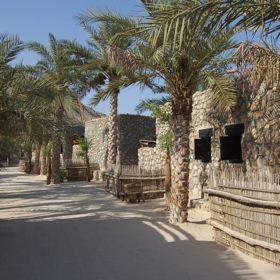 As our SUV bounced and jostled up the winding dirt road, I tried to keep my eyes on the hilltop in order to quell the rising tide of nausea that was threatening to envelop me.
As our SUV bounced and jostled up the winding dirt road, I tried to keep my eyes on the hilltop in order to quell the rising tide of nausea that was threatening to envelop me.
I was on my way to a beach resort in Oman, Dubai’s neighbor, which I had been told was in a beautiful, secluded cove far from civilization.
However, I was not aware that getting there would be an adventure in itself, involving a trek over a perilous mountain road with no guard rail and no lights.
Thankfully, the bumpy part of the ride only encompassed the last 10 minutes of the journey from Dubai. And on the final descent into Zighy Bay we were rewarded with a stunning view of a wide stretch of the Musandam peninsula and the Arabian Gulf, with views across the Strait of Hormuz all the way to Iran.
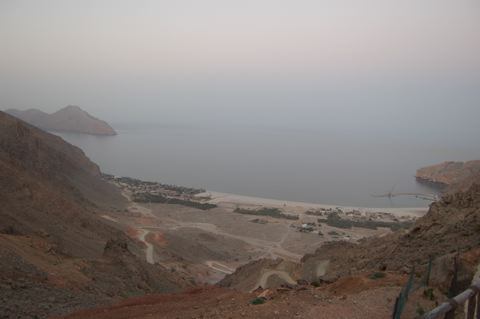 It takes about two hours to get to the Omani exclave of Musandam from Dubai, on a road that heads due east through cityscapes, deserts and mountains. Camels loll under shade trees alongside the highway, munching aimlessly on the sparse desert grass, while the occasional patch of date trees offers a refreshing splash of green amid the relentless expanse of yellow sand.
It takes about two hours to get to the Omani exclave of Musandam from Dubai, on a road that heads due east through cityscapes, deserts and mountains. Camels loll under shade trees alongside the highway, munching aimlessly on the sparse desert grass, while the occasional patch of date trees offers a refreshing splash of green amid the relentless expanse of yellow sand.
The journey takes you through Sharjah, Ras al Khaimah, and Umm al Quwein, three Emirates that border Dubai. Not many Americans are aware that Dubai is one of seven emirates that make up the UAE (the other three are Fujeirah, Ajman, and Abu Dhabi). Formerly British protectorates, the emirates federated by mutual agreement in 1971 and became independent.
Each emirate has its own ruler, or sheikh, but the federation as a whole has a single president who is elected by all the others. Some of the emirates are large and developed, like Dubai and Abu Dhabi, while others are small and not terribly built up, like Fujeirah and Umm al Quwein.
Just to the east of the UAE is the Sultanate of Oman, which was to be the final destination on my trip. Unlike Abu Dhabi and Dubai, which are rapidly modernizing outposts of commercial activity and Western culture, Oman is more low-key and conservative.
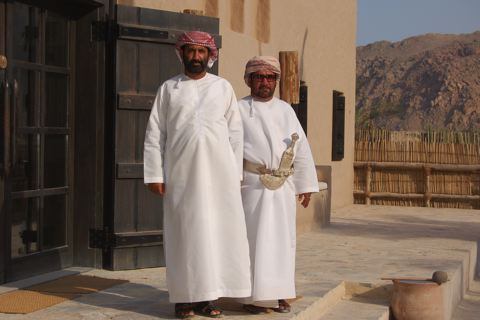 Though the country has oil wealth and its roads and infrastructure are well-maintained, most Omanis live in modest white low-rise houses, dress in traditional Arabic dress, and live unassuming lives in the small dusty towns scattered throughout the desert, mountains and coastline.
Though the country has oil wealth and its roads and infrastructure are well-maintained, most Omanis live in modest white low-rise houses, dress in traditional Arabic dress, and live unassuming lives in the small dusty towns scattered throughout the desert, mountains and coastline.
Oman is ruled by a sultan, which is basically the same thing as a sheikh. Sultan Qaboos ibn Sa‘id has been the absolute monarch of this country of approximately 2.5 million people since 1970. His portrait appears in every gas station, barber shop and library in the land. In fact, it’s required by law, but since Omanis are quite patriotic, they display the image of their leader with pride.
Unlike Dubai, there is not much Western-style tourism in Oman outside of the capital of Muscat, and even less in the remote Musandam peninsula. This is probably because it doesn’t really have the modern diversions that most Western tourists take for granted, such as movie theaters, shopping malls, bars, and restaurants.
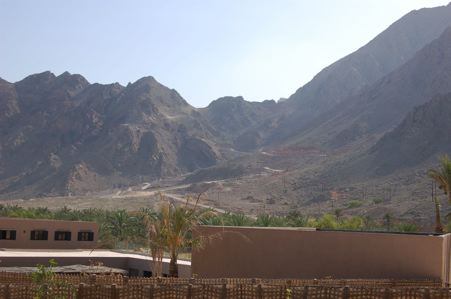 But it does have stunning deserts, cliffs, beaches, and castles that offer a certain authentic charm that is lacking in many built-up destinations.
But it does have stunning deserts, cliffs, beaches, and castles that offer a certain authentic charm that is lacking in many built-up destinations.
There is also a smattering of high-end beach resorts that cater to foreigners, such as the place I stayed, the Six Senses resort in Zighy Bay. Six Senses is one of the few—if not the only— resort in the Musandam peninsula, and to its credit it integrates itself with the simple, stark rhythms of Omani life, rather than building a wall around itself to shut them out.
Goats amble into the resort from the hills high above, foraging for grass and scraps around diners at the cliffside restaurant. Falcons linger regally on rooftops, occasionally swooping down to peer at bathers on the beach. The call of the muezzin can be heard five times a day from the tiny beachside mosque, a reminder that the 100 or so inhabitants of the adjacent village are going about their business the same way as they have for hundreds of years.
The men, clad in traditional long white dishdasha (caftans), thick beards, and red checkered kaffiyeh (headscarves) spend their days at sea, earning a healthy living catching fish that is sold en masse to merchants in Dubai. The women, obscured from head to toe in long black abayas, pray in the mosque or take the boat to schools and markets in Dibba, the town in the adjacent cove.
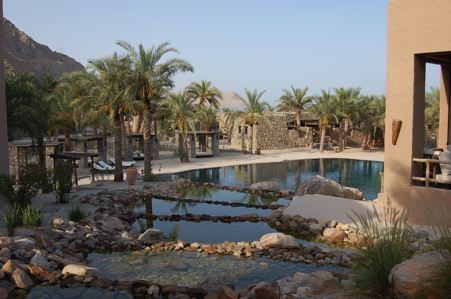 Though Zighy Bay’s inhabitants are accustomed to foreigners due to their proximity to the resort, many of the other coves along the peninsula exist in almost virtual isolation from the rest of the world. Tiny villages of 20, 30 or 100 people lurk between near-vertical cliffs and are only accessible by boat, but not to Westerners.
Though Zighy Bay’s inhabitants are accustomed to foreigners due to their proximity to the resort, many of the other coves along the peninsula exist in almost virtual isolation from the rest of the world. Tiny villages of 20, 30 or 100 people lurk between near-vertical cliffs and are only accessible by boat, but not to Westerners.
Even at Zighy the resort staff must get permission in advance to enter the village, in order to forewarn the women, who are not allowed to be seen by foreign men. Six Senses staff and guests help rebuild houses in the village as part of the resort’s social responsibility program. The program also includes giving a portion of the profits back to the community, plus water conservation, waste management, and ecological protection measures.
Part of the appeal of the resort is that fact that it is built in traditional Omani village style using basic materials such as stone, sand, native woods, and palm tree leaves. The villas are immaculate and ultra-luxurious without being flashy, and the resort boasts a staff of 350 people. If you consider that there are only 82 villas, most of them double occupancy, that means the staff-to-guest ratio is more than two to one.
The only drawback of the place is that the beach suffers from occasional red tides, which those who have experienced one know is not a pleasant experience. This overgrowth of oceanic algae makes the water murky and kills the fish, generally creating a big stink.
The resort has little control over when and how often these algal blooms occur, but tries to compensate for them by offering to move guests out of beachfront villas to rooms further from the water, or taking people offsite for complementary scuba diving or desert expeditions.
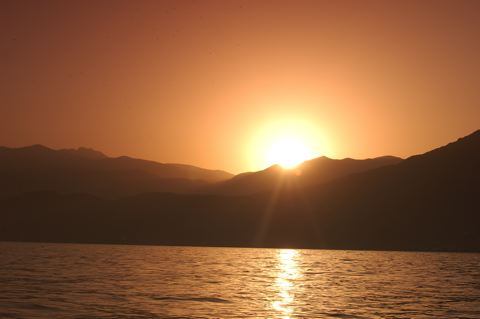 This is not a bad trade, because having sampled the diving myself, I can tell you that there is an abundance of incredible marine life, from giant seahorses to Moray eels, to stingrays and sea snails.
This is not a bad trade, because having sampled the diving myself, I can tell you that there is an abundance of incredible marine life, from giant seahorses to Moray eels, to stingrays and sea snails.
Other excursions include paragliding off the cliffs down onto the beach (with the aid of an instructor) or exploring the adjacent mountains, where you can visit the remains of Sabatyn, a village that was abandoned more than 100 years ago. Now only goats inhabit its eerily quiet streets and alleyways.
I flew back to the USA after spending five days in Dubai, and two days in Oman. The 15 ½ hour flight crossed over the steppes of central Asia and Siberia before arcing over the icebergs of the North Pole then heading down through Canada to Los Angeles.
Too bad the Middle East is so very far from the U.S. The distance puts it out of reach for many Americans, even if only in a psychological sense. But for those willing to overcome the challenges, it can be a trip of a lifetime.
By Karen Elowitt for PeterGreenberg.com.
For more information, check out:
- Dispatch from Dubai, Part One: Getting There
- Dispatch from Dubai, Part Two: Visions of the Future
- Dispatch from Dubai, Part Three: Dispelling Middle Eastern Myths
- Dispatch from Dubai, Part Four: A Peek Into the Lavish Lifestyle
- A Day in Dubai Without Spending a Dime
- Off the Brochure Travel Guide: Doha, Qatar
- Middle Eastern Travel Section












